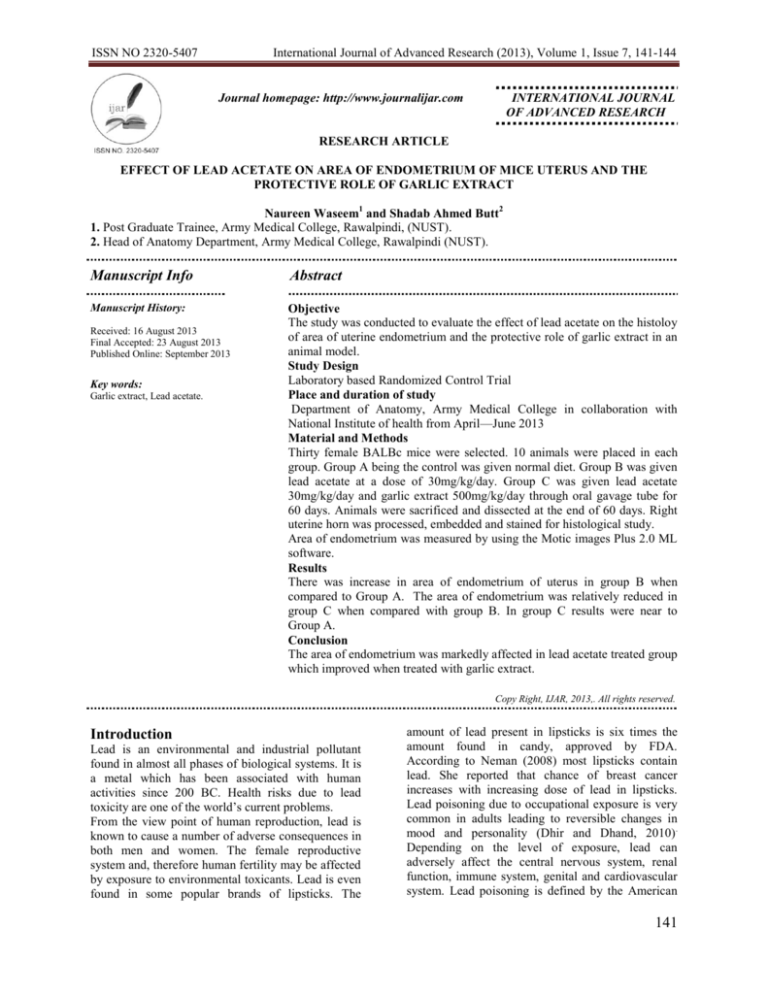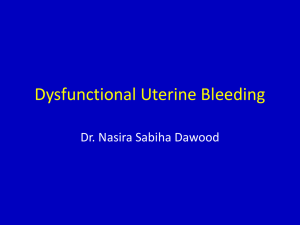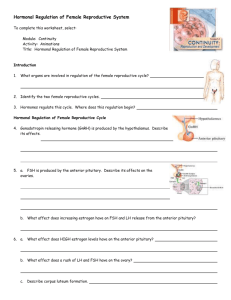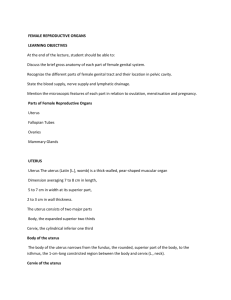
ISSN NO 2320-5407
International Journal of Advanced Research (2013), Volume 1, Issue 7, 141-144
Journal homepage: http://www.journalijar.com
INTERNATIONAL JOURNAL
OF ADVANCED RESEARCH
RESEARCH ARTICLE
EFFECT OF LEAD ACETATE ON AREA OF ENDOMETRIUM OF MICE UTERUS AND THE
PROTECTIVE ROLE OF GARLIC EXTRACT
Naureen Waseem1 and Shadab Ahmed Butt2
1. Post Graduate Trainee, Army Medical College, Rawalpindi, (NUST).
2. Head of Anatomy Department, Army Medical College, Rawalpindi (NUST).
Manuscript Info
Abstract
Manuscript History:
Objective
The study was conducted to evaluate the effect of lead acetate on the histoloy
of area of uterine endometrium and the protective role of garlic extract in an
animal model.
Study Design
Laboratory based Randomized Control Trial
Place and duration of study
Department of Anatomy, Army Medical College in collaboration with
National Institute of health from April—June 2013
Material and Methods
Thirty female BALBc mice were selected. 10 animals were placed in each
group. Group A being the control was given normal diet. Group B was given
lead acetate at a dose of 30mg/kg/day. Group C was given lead acetate
30mg/kg/day and garlic extract 500mg/kg/day through oral gavage tube for
60 days. Animals were sacrificed and dissected at the end of 60 days. Right
uterine horn was processed, embedded and stained for histological study.
Area of endometrium was measured by using the Motic images Plus 2.0 ML
software.
Results
There was increase in area of endometrium of uterus in group B when
compared to Group A. The area of endometrium was relatively reduced in
group C when compared with group B. In group C results were near to
Group A.
Conclusion
The area of endometrium was markedly affected in lead acetate treated group
which improved when treated with garlic extract.
Received: 16 August 2013
Final Accepted: 23 August 2013
Published Online: September 2013
Key words:
Garlic extract, Lead acetate.
Copy Right, IJAR, 2013,. All rights reserved.
Introduction
Lead is an environmental and industrial pollutant
found in almost all phases of biological systems. It is
a metal which has been associated with human
activities since 200 BC. Health risks due to lead
toxicity are one of the world’s current problems.
From the view point of human reproduction, lead is
known to cause a number of adverse consequences in
both men and women. The female reproductive
system and, therefore human fertility may be affected
by exposure to environmental toxicants. Lead is even
found in some popular brands of lipsticks. The
amount of lead present in lipsticks is six times the
amount found in candy, approved by FDA.
According to Neman (2008) most lipsticks contain
lead. She reported that chance of breast cancer
increases with increasing dose of lead in lipsticks.
Lead poisoning due to occupational exposure is very
common in adults leading to reversible changes in
mood and personality (Dhir and Dhand, 2010) .
Depending on the level of exposure, lead can
adversely affect the central nervous system, renal
function, immune system, genital and cardiovascular
system. Lead poisoning is defined by the American
141
ISSN NO 2320-5407
International Journal of Advanced Research (2013), Volume 1, Issue 7, 141-144
Academy of Pediatrics as blood lead levels higher
than 10µg/dl (Ragan and Turner, 2009). Same levels
were considered as a cause of concern by World
Health Organization (Barbosa et al., 2005).
Lead being one of the reproductive toxicant, can
affect the gonadal structure and functions and can
cause alterations in fertility (Qureshi and Sharma,
2012). Most of the available literature is related to the
action of lead on male subjects. The effects on the
physiology, histomorphology, development and
biomarkers have been observed on different organs of
animals and humans. In most of the previous studies,
the harmful effects of lead were noted (Eugenia et al.,
2009; Yousaf and Abdullah, 2010; Ait et al., 2009)
For centuries fruits and vegetables have attributed to
beneficial health effects. In recent years, research
work threw light on the use of plants on the
reproductive health of man and animals (Raji et al.,
2012). Garlic (Allium Sativum) is one of the studied
plants, with a long history of therapeutic use. Health
benefits of garlic have been extensively reported
(Sharma et al., 2010; Asadaq and Inamdar, 2010). It
exhibits antioxidant properties due to rich
organosulphur compounds. Data suggests that
antioxidants have an important role in abating some
hazards of lead.
Reports on the effects of garlic on female
reproductive system are yet to be established (Raji et
al., 2012). The rationale of current study is to observe
the effects of lead acetate on female reproductive
organs and the protective role of garlic extract.
Material and Methods
This laboratory based randomized controlled trial
was conducted in the Department of Anatomy, Army
Medical College Rawalpindi, in collaboration with
National Institute of Health (NIH), Islamabad from
April—June 2013. The experiment was carried out
with permission of ethical committee on animal
experiments, of the Army Medical College,
Rawalpindi.
The animals were randomly divided into three equal
groups using random number table. Thirty female
BALB/c mice weighing 25-27 grams were used in
the experiment and were housed in controlled
environment of Animal house of NIH, Islamabad.
Mice were fed with NIH laboratory diet for two
months.
Animals in group A served as Control and were fed
on normal diet. Mice in experimental group B were
given lead acetate at a dose of 30 mg/kg body weight
once daily for two months by oral gavage tube.
Animals in group C were given lead acetate at a dose
of 30mg/kg body weight once daily along with garlic
extract 500 mg/kg through oral gavage tube once
daily for two months.
At the end of 60 days, the animals were anaesthetized
by placing ether soaked cotton in the jar. The animals
were placed on a clean sheet of paper on a dissecting
board. The midline incision was made on the skin of
the abdomen by scalpel. The flaps in the body wall
were spread open by making lateral incisions and
were pinned back to expose the organs. Right uterine
horn was removed and was placed in 10 percent
formalin in duly labeled plastic containers. Then the
uterine horn was processed and embedded. Tissues
were cut into 5 microns thick sections using rotary
microtome. The sections were stained with
autostainer with Hematoxylin and Eosin (H&E) for
routine histological study of uterus.
Histopathological study
Area of the endometrium
Area of the endometrium was calculated by using the
Motic images Plus 2.0 ML software. The software
was properly calibrated for X4 objective with the
calibration slide provided with the microscope
Model: DMB 3.223. The slides of the endometrium
were then focused on the screen. Capture command
was selected for taking images of the slides using
motic live imaging module. The images were
automatically transferred and saved in the computer.
The images were properly zoomed in to focus the
area of interest. After that the “irregular” tool was
selected for measurement of area. The luminal area
was outlined on the luminal surface of the
endometrium and marked as area 1. The “irregular”
tool was again selected to mark the border of the
endometrium at the junction with myometrium and
marked as area 2. The area of the endometrium was
then calculated by subtracting the area 1 from area 2.
The final reading was recorded as the area of the
endometrium for that slide (Qamar, 2011).
Statistical analysis
The data was analyzed by using statistical package
for social services (SPSS) version 18. Descriptive
statistics were used to describe the results. The
significance difference was determined using
ANOVA and Post Hoc Tuckey test. Results were
considered significant at p<0.05.
Results
The uterine wall of control group showed three layers
(endometrium, myometrium and perimetrium). The
endometrium consisted of simple columnar
epithelium and an underlying connective tissue
stroma with glands (Fig-1a). Myometrium consisted
of thick inner circular layer and a thinner outer
longitudinal layer of smooth muscle. Perimetrium is
the outer serosal layer.
The H&E stained slides of group B showed increase
in area of endometrium in animals exposed to lead in
142
ISSN NO 2320-5407
International Journal of Advanced Research (2013), Volume 1, Issue 7, 141-144
experimental group B (fig -1b, table-1). There was
increase in number and size of the uterine glands
when compared to the control. The uterus sections in
experimental group C showed microscopic picture
that closely approximate that of the control group.
The area of the endometrium was reduced when
compared to experimental group B. The glands were
of uniform size and reduced in number when
compared to experimental group B.
Significant results were present between groups A
and B regarding area of endometrium. Results were
statistically insignificant when group B was
compared to group C. The results of group C were
not significantly different when compared with
control group (table-2).
TABLE-1: Comparison of mean values of area of
endometrium between groups
Group A
Group B
Group
p(n = 10)
(n = 10)
C
val
(n = 10)
ue
Area of
Endom
etrium
1.2518E7 ±
3.72004E6
1.9529E 1.6988E
7±
7±
4.53657 4.99966
E6
E6
Values were described as Mean ± SD
0.0
05
Group A vs. Group B
Group A vs. Group C
Group B vs. Group C
p-value
significance
p-value
significance
p-value
0.004
< 0.05
0.081
> 0.05
0.420
*p-value <0.05 siginificant
**p-value <0.001 highly siginificant
Discussion
(b)
Figure- 1 Cross section of uterus of control group
showing normal structure of endometrium (Em)
seen in fig (a), Epi; simple columnar epithelium,
Ug; uterine glands, Mm; myometrium, and
increase in area of endometrium with dilated
glands seen in fig (b) at 40X (H&E) in
experimental group B
< 0.05
TABLE-2 Statistical significance of area of
endometrium in control group A and
experimental group B and C
Area of
Endometrium
(a)
Significance
The objective of this study was to see the effects of
lead acetate on the histology of area of endometrium
of mice uterus and the protective role of garlic
extract. In the present study lead induced histological
alterations in the area of endometrium of uterus and
the changes were ameliorated with administration of
garlic extract. The experimental groups were
compared with the control group, as well as with
each other. The results of group B were compared
with group C and of group A with group C. In a
previos study Tchernitchin et al., 2011 reported
endometrial stroma edema as a result of estrogen
action when rats were exposed to lead prenatally. In
our study, statistically significant results on
comparison of group A and group B showed that lead
acetate led to endometrial hyperplasia which resulted
in increase in area of endometrium. This might be
due to endometrial edema or increased glandular
hyperplasia. Secondly endometrial cells require a
balance between estrogen and progesterone. The
disturbance of this balance may lead to constant
endometrial proliferation (Qamar, 2011). This may
be a cause of increase rates of infertility,
miscarriages, still birth and poor infant outcomes
associated with exposure to lead (Qureshi and
Sharma, 2012). On the other hand statistically
insignificant results on comparison of group B and
group C showed that garlic slightly improved the area
of the endometrium histologically, but the results
143
Significanc
e
> 0.05
ISSN NO 2320-5407
International Journal of Advanced Research (2013), Volume 1, Issue 7, 141-144
were statistically insignificant when these two groups
were compared. This might be due to estrogen like
actions of garlic being one of the famous
phytoestrogen (Sherin, 2011).
This study showed increase in area of endometrium
in experimental group B as compared to control
group A. After treatment with garlic extract, there
was relatively decrease in area of endometrium as
compared to experimental group B. Results were
significant between control A and experimental
group B. The results were not significantly different
between experimental group C and control group A
showing that lead acetate led to increase in area of
endometrium which improved after co administration
of garlic extract.
Conclusion
The results lead to the conclusion that persistence and
exposure to lead in our environment seemed to have
effects on the histomorphology of uterus which
improved after treatment with garlic extract. More
significant results existed when group A was
compared with group B. The changes were more
obvious in group B exposed to lead acetate for 2
months as compared to group C which was
coexposed to garlic extract. Results between A and C
were not statistically significant as the mean readings
were close to each other. So it can also be concluded
that garlic extract played a protective role, resulting
in improvement of the tissue exposed to lead.
Acknowledgements
Authors express gratitude to Lt Col Khadija Qamar
(Associate Professor, Anatomy Department, Army
Medical College) for assistance and help.
References
Environmental health perspectives, 113(12): 166974.
Dhir, V. and Dhand, P. (2010). Toxicological
approach in chronic exposure to lead on reproductive
functions in female rats. Toxicol Int., 17(1); 1-7.
Eugenia, D., Alexandra, T., Diana, A. and Cristina,
R. T. (2009). The consequences in utero exposure to
lead acetate on exposure and integrity biomarkers of
reproductive system in female rats.
Medicina
veterinara, XLII(2): 295-300.Neman, N. (2008).
www.wingsandheros.com/articles/general-healthwellness-news-tips/lipstick-information-drnahidneman-mt-sinai-hospital.html
Qamar, K. (2011). Effect of mifepristone, a
progesterone antagonist on the morphology of the rat
uterus. FCPS thesis, College of Physicians and
Surgeons, Pakistan.
Qureshi, N. and Sharma, R. (2012). Lead toxicity and
infertility in female swiss mice: A review. Journal of
Chemical, Biological and Physical Sciences, 2(4):
1849-1861.
Ragan, P. and Turner, T. (2009). “Working to prevent
lead poisoning in children: getting the lead out”
JAAPA: Official journal of American Academy of
Physician Assistants, 22(7): 40-45.
Raji, L. O., Fayemi, O. E., Ameen S. A. and Jagun,
A. T. (2012). The effects of aqueous extract of allium
sativum (garlic) on some aspects of reproduction in
the female albino rat (wister strain). Global
Veterinaria, 8(4): 414-420.
Sharma, V., Sharma, A. and Kansal, L. (2010). The
effect of oral administration of allium sativum
extracts on lead nitrate induced toxicity in male mice.
Food Chem Toxicol., 48: 928-936.
Ait, H. N., Slimani, M., Merad, B.B. and Zaoiu, C.
(2009). Reproductive toxicity of lead acetate in adult
male rats. American Journal of Scientific Research,
3: 38-50.
Asadaq, S. M. B. and Inamdar, M. N. (2010).
Pharmacodynamic and pharmacokinetic interactions
of propanolol with garlic (Allium Sativum) in rats.
Evidence Based Complementary and Alternative
medicine, 1-11.
Sherin, W. (2011). Histological and ultrastructural
changes in the adult male albino rat testis following
chronic crude garlic consumption. Annals of
Anatomy, 193: 134-141.
Barbosa, J. F., Tanus-Santos, J. E., Gerlach R. F. and
Parsons, P. J. (2005). A critical review of biomarkers
used for monitoring human exposure to lead:
advantages,
limitations
and
future
needs.
Yousif, W. H. and Adbullah, S. T. (2010).
Reproductive efficiency of rats whose mothers
treated with lead acetate during lactation: role of
vitamin E. Iraqi Journal of Veterinary Sciences,
24(1): 27-34.
Tchernitchin, A. N., Gaete, L., Bustamante, R. and
Baez, A. (2011). Effect of prenatal exposure to lead
on estrogen action in the prepubertal rat uterus. ISRN
Obstret Gynecol., doi 10.5402/2011/329692.
144







